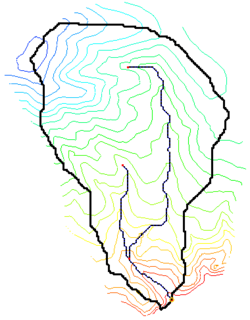WMS:Map Module: Difference between revisions
No edit summary |
No edit summary |
||
| (7 intermediate revisions by the same user not shown) | |||
| Line 1: | Line 1: | ||
[[File:MapModuleExample.png|thumb|250 px|Examples of arcs drawn over DEM data in the Map module]] | [[File:MapModuleExample.png|thumb|250 px|Examples of arcs drawn over DEM data in the Map module]] | ||
The '''Map''' [[File:Map Module Icon.svg|16px]] module provides a [[WMS:Map Tools|suite of tools]] for defining watershed data. It | The '''Map''' [[File:Map Module Icon.svg|16px]] module provides a [[WMS:Map Tools|suite of tools]] for defining watershed data using [[WMS:Feature Objects|feature objects]]: points, arcs, and polygons. It is accessed by clicking the [[File:Map Module Icon.svg|16px]] icon on the [[WMS:Modules|Module toolbar]]. These feature objects are grouped onto [[WMS:Coverages|coverages]], similar to a layer or level in a CAD drawing. Each coverage represents a particular set of information. For example, one coverage could be used to define drainage boundaries, and another coverage could be used to define [[WMS:Land Use Coverage|land use]] and [[WMS:Soil Type Coverage|soil zones]]. | ||
Land use and soil zones can be used to compute curve numbers or map other important modeling parameters for hydrologic analysis. Other examples of coverage usage include: | |||
*Computing [[WMS:Lag Time and Time of Concentration|time of concentration or lag time]] | |||
*Defining [[WMS:1D-HYD Cross Section Coverage Type|cross sections]] | |||
*Mapping [[WMS:NSS Region Coverage|NSS regions]] | |||
*Mapping rainfall and other parameters for the [[WMS:MODRAT|LA County modified rational (MODRAT) model]] | |||
*Streams for 2D analysis using [[WMS:GSSHA|GSSHA]] | |||
The Map module uses the information to directly create and manage hydrologic and hydraulic models. The [[WMS:Map Tools|map tools]] can also be used as a support utility for data development with either [[WMS:TIN Guidelines|TINs]] or [[WMS:DEM Guidelines|DEMs]]. Results of watershed and floodplain delineations can be saved in the map module and converted to GIS data layers for export. | |||
Background maps from the [[WMS:GIS Module|GIS]] and [[WMS:Terrain Data Module|Terrain Data modules]] can be used as guides for digitizing feature objects in the Map madule. A rough boundary and stream network can also be used to generate a TIN or two-dimensional finite difference grid that conforms precisely to streams and other important hydrologic features. | |||
The Map module is included with all [http://www.aquaveo.com/software/wms-pricing editions] of WMS. [[Category:Link to Store]] | The Map module is included with all [http://www.aquaveo.com/software/wms-pricing editions] of WMS. [[Category:Link to Store]] | ||
==Related Topics== | ==Related Topics== | ||
* [[WMS: | * [[WMS:Map Tools|Map Tools]] | ||
* [[WMS:Feature Objects Menu|Feature Objects Menu]] | |||
* [[WMS:Feature Objects|Feature Objects]] | * [[WMS:Feature Objects|Feature Objects]] | ||
* [[WMS:CAD Data|CAD Data]] | * [[WMS:CAD Data|CAD Data]] | ||
* [[WMS:Where Can I Get Data?|Data Acquisition]] | * [[WMS:Where Can I Get Data?|Data Acquisition]] | ||
Latest revision as of 22:09, 18 December 2019
The Map ![]() module provides a suite of tools for defining watershed data using feature objects: points, arcs, and polygons. It is accessed by clicking the
module provides a suite of tools for defining watershed data using feature objects: points, arcs, and polygons. It is accessed by clicking the ![]() icon on the Module toolbar. These feature objects are grouped onto coverages, similar to a layer or level in a CAD drawing. Each coverage represents a particular set of information. For example, one coverage could be used to define drainage boundaries, and another coverage could be used to define land use and soil zones.
icon on the Module toolbar. These feature objects are grouped onto coverages, similar to a layer or level in a CAD drawing. Each coverage represents a particular set of information. For example, one coverage could be used to define drainage boundaries, and another coverage could be used to define land use and soil zones.
Land use and soil zones can be used to compute curve numbers or map other important modeling parameters for hydrologic analysis. Other examples of coverage usage include:
- Computing time of concentration or lag time
- Defining cross sections
- Mapping NSS regions
- Mapping rainfall and other parameters for the LA County modified rational (MODRAT) model
- Streams for 2D analysis using GSSHA
The Map module uses the information to directly create and manage hydrologic and hydraulic models. The map tools can also be used as a support utility for data development with either TINs or DEMs. Results of watershed and floodplain delineations can be saved in the map module and converted to GIS data layers for export.
Background maps from the GIS and Terrain Data modules can be used as guides for digitizing feature objects in the Map madule. A rough boundary and stream network can also be used to generate a TIN or two-dimensional finite difference grid that conforms precisely to streams and other important hydrologic features.
The Map module is included with all editions of WMS.
Related Topics
WMS – Watershed Modeling System | ||
|---|---|---|
| Modules: | Terrain Data • Drainage • Map • Hydrologic Modeling • River • GIS • 2D Grid • 2D Scatter |  |
| Models: | CE-QUAL-W2 • GSSHA • HEC-1 • HEC-HMS • HEC-RAS • HSPF • MODRAT • NSS • OC Hydrograph • OC Rational • Rational • River Tools • Storm Drain • SMPDBK • SWMM • TR-20 • TR-55 | |
| Toolbars: | Modules • Macros • Units • Digitize • Static Tools • Dynamic Tools • Drawing • Get Data Tools | |
| Aquaveo | ||
